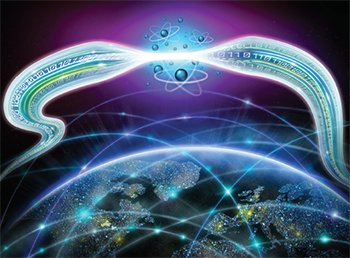 In this artist’s conception, light propagating in a glass fiber interacts with cold cesium atoms in the vicinity of the narrow portion of the fiber. The interaction allows the light to be halted and reemitted later on demand, to create a potential all-fiber memory for quantum networks. [Julia Fraud, www.juliafraud.com/Laboratoire Kastler Brossel]
In this artist’s conception, light propagating in a glass fiber interacts with cold cesium atoms in the vicinity of the narrow portion of the fiber. The interaction allows the light to be halted and reemitted later on demand, to create a potential all-fiber memory for quantum networks. [Julia Fraud, www.juliafraud.com/Laboratoire Kastler Brossel]
Light propagates in optical fiber at speeds as fast as 200,000 km/s. This year, we have demonstrated a way to stop and store light within fiber and later release it on demand, and thereby to create an optical memory system within the fiber itself.1
This capability represents an important advance in optical communications. Fibers lie at the heart not only of the worldwide telecommunications system, but also of any future quantum Internet,2 in which quantum information is transported and synchronized between interconnected nodes. Previous optical memory demonstrations had been based on free-space ensembles of atoms,3 not on a wave-guided implementation compatible with fibers used in networks.
At the core of the device is a commercial fiber, with a short section elongated and narrowed to 400 nanometers in diameter. In that section, light in the fiber can efficiently interact with a cloud of laser-cooled atoms. Using the technique of electromagnetically induced transparency—well-known in free-space optics, but previously not combined with a fiber system— we were able to slow down the light pulse by 3,000-fold and then to halt it completely.
The information conveyed by the laser light was transferred to the atoms in the form of a collective excitation—a large quantum superposition. Around 2,000 cesium atoms very close to the fiber were involved in the process. Later, after a programmable time, the light was released into the fiber, reconstituting the initial encoded information, which once again continued its travel through the rest of the fiber. We demonstrated storage times up to 5 μs, which would correspond to a traveling distance of 1 km if the light had not been halted.
The experiment also showed that even light pulses containing only a single photon can be stored, with a very large signal-to-noise ratio. This feature should enable the use of this device as a quantum memory, an essential ingredient for the creation of future quantum networks.
Researchers
B. Gouraud, D. Maxein, A. Nicolas, O. Morin, and J. Laurat, Laboratoire Kastler Brossel, UPMC–Sorbonne Universités, Paris, France
References
1. B. Gouraud et al. Phys. Rev. Lett. 114, 180503 (2015).
2. H.J. Kimble. Nature 453, 1023 (2008).
3. N. Sangouard et al. Rev. Mod. Phys. 83, 33 (2011).
